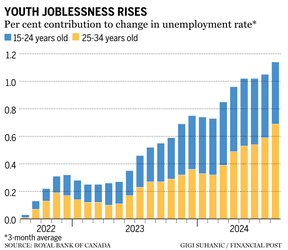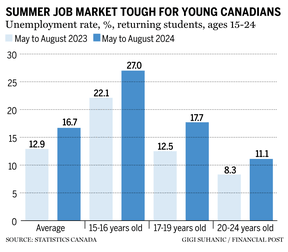A stunning 80% of the increase in the unemployment rate is coming from people under the age of 35, an RBC report finds

Article content
Sana has been no stranger to rejections, as she has applied to hundreds of jobs since getting laid off last year.
“The hiring system is pretty broken,” said Sana, 27, who did not want her last name used because she continues to look for work.
She notes the issues she has faced are not unique to her industry. In fact, she is one of the large number of under-35-year-olds who are driving an increase in the unemployment rate in Canada.
Advertisement 2
Article content
“There’s no loyalty from organizations; they’re not approaching things from a way that’s recognizing the systemic failures that they have, like actually supporting and uplifting young people.”
Sana said that many organizations still require prior experience for entry-level roles or prefer hiring someone they already know or who is connected to them in some way.
While volunteer work can be an option for students and new graduates to build experience, Sana said this route is not sustainable for people who have bills to pay.
Sana, who lives with her family, said she did some unpaid work for a company that specialized in diversity, equity and inclusion (DEI) work before landing her first full-time job there after completing her master’s program.
“It was definitely a role that I learned the most from, but it was also exploitative,” Sana said, explaining that she worked in an fast-paced and demanding environment for little pay and no work-life balance. She said she ended up working long hours, sometimes ending the workday at 8 p.m.
Sana worked there for about two years before she was laid off in March, 2023.
Advertisement 3
Article content
“I was very distraught,” she recounted. “I reached out to several folks after about a month or two, when I had been able to somewhat process the situation and could talk about it without getting too upset.”
But in the past year in particular, Sana has found the labour market harder to navigate. It’s taking longer to hear back from companies, land any interviews and, most importantly, secure a job.

Young people driving unemployment
Statistics Canada data showed job vacancies plunged by 59,000, or 9.2 per cent, in the second quarter of the year — more than double the decline reported in the previous quarter.
A recent report from Royal Bank of Canada (RBC) revealed that company layoffs aren’t driving the increase in the unemployment rate — which, as of September, is sitting at about 6.5 per cent — since the number of employed workers hasn’t declined.
Instead, 80 per cent of the increase in the unemployment rate is coming from people under the age of 35 — largely from students and new graduates, who take longer to find a first job.
Carrie Freestone, an RBC economist who co-authored the report, said this is a new trend she first noticed toward the end of last year.
Article content
Advertisement 4
Article content
During typical labour market corrections, such as in the 2008 financial crisis, an uptick in the unemployment rate is often triggered by mass layoffs, she explained. But many companies are still “scarred” from the hiring challenges they faced in 2022, when job vacancies soared to record highs.
“Once we come out of this period of weaker demand, once interest rates fall and consumer demand picks up, we could be in a situation where firms need to hire again,” Freestone said. “They know it’s hard to hire.”
While she has seen some companies, particularly in the technology sector, lay off staff, Freestone said hiring freezes have become much more common instead.
And younger people, especially those trying to land their first jobs with no prior experience, are struggling the most. A separate report from Statistics Canada detailed that the unemployment rate for youth aged 15 to 24 during the summer of 2024 was the highest since 2012.
“We are in a full-out screaming crisis,” warned Ilona Dougherty, the co-creator and managing director of the Youth & Innovation Project at the University of Waterloo. “We need to recognize that it’s a really tough job market, and you can do everything right and still unfortunately end up in that pool of 19,000 people.”
Advertisement 5
Article content

Not thriving at work
Dougherty said that even young people who are working right now aren’t necessarily thriving in their jobs.
She pointed to a recent youth-focused study the University of Waterloo conducted in partnership with RBC, which found young women are paid significantly less than young men and young immigrants are less likely to feel as though they are learning and enjoying their careers.
Sana found work at a consulting agency a few months after being laid off, but explained she was originally working part-time hours (about eight to 20 hours a month) as needed. Even today, although she feels like she is closer to full-time hours and she is receiving a steady flow of income each month, she does not have an official contract with her employer and is keeping an eye out for other opportunities.
“I’m looking for more stability, perhaps at a larger organization, where I don’t feel like I’m going to get laid off in another year or two,” she said. She added that she feels she has been stagnating in entry-level pay, at between $50,000 to $60,000 a year.
‘Bar getting higher and higher’
Advertisement 6
Article content
Mishika Khurana, a 21-year-old master of spatial analysis student at Toronto Metropolitan University, explained that many companies are looking for candidates with prior experience and relevant skills — skills that many aren’t necessarily acquiring from their undergraduate programs.
She has seen many of her peers staying in school longer and adding to their credentials, which could be skewing the unemployment rate for their cohort, as well. Statistics Canada data dating back to the 1995-1996 academic years shows the university participation rate for people aged 18 to 24 has grown from 19 per cent to 30 per cent.
Meanwhile, Khurana said young people need to “play the game” and send out scores of applications just to get a couple of interviews and a potential job offer.
Ian Korovinsky, a 19-year-old software engineering student at the University of Waterloo, interned at Bloomberg over the past summer and plans to return next year. But he said the journey getting there was not easy, even though he has been building experience since high school.
Korovinsky found the internship internally through WaterlooWorks, the university’s online job database for co-op students, and landed the position after passing the technical interview.
Advertisement 7
Article content
But when he was still applying to jobs, he estimates he sent about 250 to 300 applications, plus 100 personalized reach-outs through cold emailing and messages to employees through LinkedIn.
“The bar is getting higher and higher,” he said. He emphasized the importance of having strong mentors to help guide young people through their job search.
International students face more barriers
Ritika Saraswat, the founder of Re-defined, an organization that aims to empower immigrants and international students in Canada, noted that international students are facing additional challenges in navigating an unfamiliar environment.
“The biggest (barrier) to entry has always been Canadian experience,” said Saraswat, explaining that even young immigrants and international students with prior work experience in other countries are having a tough time because they don’t have work experience in Canada. “It’s a cause of frustration among many.”
This is causing many young people to take up general labour to make ends meet while getting their degrees, with the intention of securing a corporate job after they graduate, she said. However, once they try to land a job in their fields later on, they still lack the necessary experience and skills, and the credentials aren’t enough to set them apart from the scores of other candidates in the same hiring pool.
Advertisement 8
Article content
RBC’s Freestone said she anticipated unemployment to inch up further to 6.8 per cent in the near term, but projected hiring will pick up slowly in the second half of next year, especially as interest rates fall.
Still, there are major consequences for young Canadians who are floundering in the current labour market. For example, those who take longer to find their first job could be impacted by lower wage gains, since they have less experience to point to when negotiating raises in the future. Others are finding themselves stuck in a rut.
Recommended from Editorial
-

1 in 3 Canadians are moonlighting on company time: survey
-

Jobless summer: Why youth unemployment is at a decade high
“I don’t know if I even have a career,” Sana acknowledged, explaining that she has often taken any job that she has been offered, but has never found an “ideal opportunity.”
“Sometimes when you get into contract-by-contract or short-term opportunities, (it feels) like you’re just going through jobs endlessly for your whole life.”
• Email: slouis@postmedia.com
Bookmark our website and support our journalism: Don’t miss the business news you need to know — add financialpost.com to your bookmarks and sign up for our newsletters here.
Article content


